Nokia 2011 Annual Report Download - page 287
Download and view the complete annual report
Please find page 287 of the 2011 Nokia annual report below. You can navigate through the pages in the report by either clicking on the pages listed below, or by using the keyword search tool below to find specific information within the annual report.-
 1
1 -
 2
2 -
 3
3 -
 4
4 -
 5
5 -
 6
6 -
 7
7 -
 8
8 -
 9
9 -
 10
10 -
 11
11 -
 12
12 -
 13
13 -
 14
14 -
 15
15 -
 16
16 -
 17
17 -
 18
18 -
 19
19 -
 20
20 -
 21
21 -
 22
22 -
 23
23 -
 24
24 -
 25
25 -
 26
26 -
 27
27 -
 28
28 -
 29
29 -
 30
30 -
 31
31 -
 32
32 -
 33
33 -
 34
34 -
 35
35 -
 36
36 -
 37
37 -
 38
38 -
 39
39 -
 40
40 -
 41
41 -
 42
42 -
 43
43 -
 44
44 -
 45
45 -
 46
46 -
 47
47 -
 48
48 -
 49
49 -
 50
50 -
 51
51 -
 52
52 -
 53
53 -
 54
54 -
 55
55 -
 56
56 -
 57
57 -
 58
58 -
 59
59 -
 60
60 -
 61
61 -
 62
62 -
 63
63 -
 64
64 -
 65
65 -
 66
66 -
 67
67 -
 68
68 -
 69
69 -
 70
70 -
 71
71 -
 72
72 -
 73
73 -
 74
74 -
 75
75 -
 76
76 -
 77
77 -
 78
78 -
 79
79 -
 80
80 -
 81
81 -
 82
82 -
 83
83 -
 84
84 -
 85
85 -
 86
86 -
 87
87 -
 88
88 -
 89
89 -
 90
90 -
 91
91 -
 92
92 -
 93
93 -
 94
94 -
 95
95 -
 96
96 -
 97
97 -
 98
98 -
 99
99 -
 100
100 -
 101
101 -
 102
102 -
 103
103 -
 104
104 -
 105
105 -
 106
106 -
 107
107 -
 108
108 -
 109
109 -
 110
110 -
 111
111 -
 112
112 -
 113
113 -
 114
114 -
 115
115 -
 116
116 -
 117
117 -
 118
118 -
 119
119 -
 120
120 -
 121
121 -
 122
122 -
 123
123 -
 124
124 -
 125
125 -
 126
126 -
 127
127 -
 128
128 -
 129
129 -
 130
130 -
 131
131 -
 132
132 -
 133
133 -
 134
134 -
 135
135 -
 136
136 -
 137
137 -
 138
138 -
 139
139 -
 140
140 -
 141
141 -
 142
142 -
 143
143 -
 144
144 -
 145
145 -
 146
146 -
 147
147 -
 148
148 -
 149
149 -
 150
150 -
 151
151 -
 152
152 -
 153
153 -
 154
154 -
 155
155 -
 156
156 -
 157
157 -
 158
158 -
 159
159 -
 160
160 -
 161
161 -
 162
162 -
 163
163 -
 164
164 -
 165
165 -
 166
166 -
 167
167 -
 168
168 -
 169
169 -
 170
170 -
 171
171 -
 172
172 -
 173
173 -
 174
174 -
 175
175 -
 176
176 -
 177
177 -
 178
178 -
 179
179 -
 180
180 -
 181
181 -
 182
182 -
 183
183 -
 184
184 -
 185
185 -
 186
186 -
 187
187 -
 188
188 -
 189
189 -
 190
190 -
 191
191 -
 192
192 -
 193
193 -
 194
194 -
 195
195 -
 196
196 -
 197
197 -
 198
198 -
 199
199 -
 200
200 -
 201
201 -
 202
202 -
 203
203 -
 204
204 -
 205
205 -
 206
206 -
 207
207 -
 208
208 -
 209
209 -
 210
210 -
 211
211 -
 212
212 -
 213
213 -
 214
214 -
 215
215 -
 216
216 -
 217
217 -
 218
218 -
 219
219 -
 220
220 -
 221
221 -
 222
222 -
 223
223 -
 224
224 -
 225
225 -
 226
226 -
 227
227 -
 228
228 -
 229
229 -
 230
230 -
 231
231 -
 232
232 -
 233
233 -
 234
234 -
 235
235 -
 236
236 -
 237
237 -
 238
238 -
 239
239 -
 240
240 -
 241
241 -
 242
242 -
 243
243 -
 244
244 -
 245
245 -
 246
246 -
 247
247 -
 248
248 -
 249
249 -
 250
250 -
 251
251 -
 252
252 -
 253
253 -
 254
254 -
 255
255 -
 256
256 -
 257
257 -
 258
258 -
 259
259 -
 260
260 -
 261
261 -
 262
262 -
 263
263 -
 264
264 -
 265
265 -
 266
266 -
 267
267 -
 268
268 -
 269
269 -
 270
270 -
 271
271 -
 272
272 -
 273
273 -
 274
274 -
 275
275 -
 276
276 -
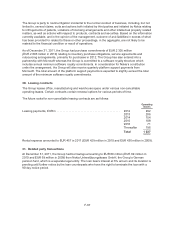 277
277 -
 278
278 -
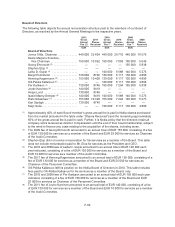 279
279 -
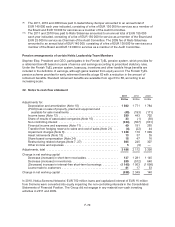 280
280 -
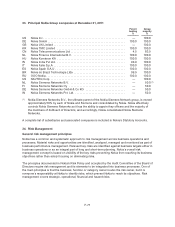 281
281 -
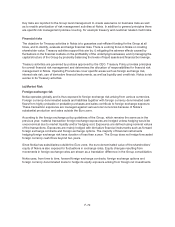 282
282 -
 283
283 -
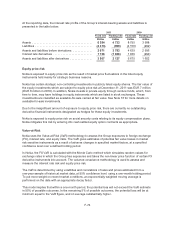 284
284 -
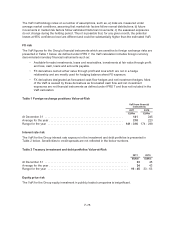 285
285 -
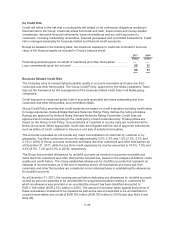 286
286 -
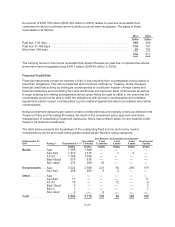 287
287 -
 288
288 -
 289
289 -
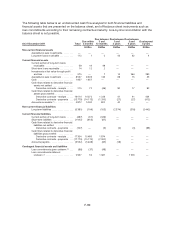 290
290 -
 291
291 -
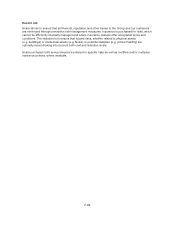 292
292 -
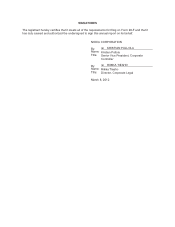 293
293 -
 294
294 -
 295
295 -
 296
296
 |
 |

An amount of EUR 316 million (EUR 472 million in 2010) relates to past due receivables from
customers for which no allowances for doubtful accounts were recognized. The aging of these
receivables is as follows:
2011 2010
EURm EURm
Past due 1-30 days ..................................................... 169 239
Past due 31-180 days ................................................... 118 131
More than 180 days .................................................... 29 102
316 472
The carrying amount of accounts receivable that would otherwise be past due or impaired but whose
terms have been renegotiated was EUR 3 million (EUR 40 million in 2010).
Financial Credit Risk
Financial instruments contain an element of risk of loss resulting from counterparties being unable to
meet their obligations. This risk is measured and monitored centrally by Treasury. Nokia manages
financial credit risk actively by limiting its counterparties to a sufficient number of major banks and
financial institutions and monitoring the credit worthiness and exposure sizes continuously as well as
through entering into netting arrangements (which gives Nokia the right to offset in the event that the
counterparty would not be able to fulfill the obligations) with all major counterparties and collateral
agreements (which require counterparties to post collateral against derivative receivables) with certain
counterparties.
Nokia’s investment decisions are based on strict creditworthiness and maturity criteria as defined in the
Treasury Policy and Operating Principles. As result of this investment policy approach and active
management of outstanding investment exposures, Nokia has not been subject to any material credit
losses in its financial investments.
The table below presents the breakdown of the outstanding fixed income and money market
investments by sector and credit rating grades ranked as per Moody’s rating categories.
At December 31,
2011 Rating (3) Total amount (1), (2)
Due within
3 months
Due between
3 and
12 months
Due between
1 and
3 years
Due between
3 and
5 years
Due beyond
5 years
EURm EURm EURm EURm EURm EURm
Banks ......... Aaa 1368 1368 — — — —
Aa1-Aa3 1 319 1 316 — 1 2 —
A1-A3 1 706 1 706 — — — —
Baa1-Baa3 616 616 — — — —
Non rated 270 260 10 — — —
Governments . . . Aaa 3 224 2 508 221 50 266 179
Aa1-Aa3 408 400 6 2 — —
Other .......... Aaa — — — — — —
Aa1-Aa3 11 — — — — 11
A1-A3 18 — — 12 — 6
Baa1-Baa3 2 — — — — 2
Ba1-C 1 — — — — 1
Non rated 2 — 2 — — —
Total .......... 8 945 8 174 239 65 268 199
F-77
